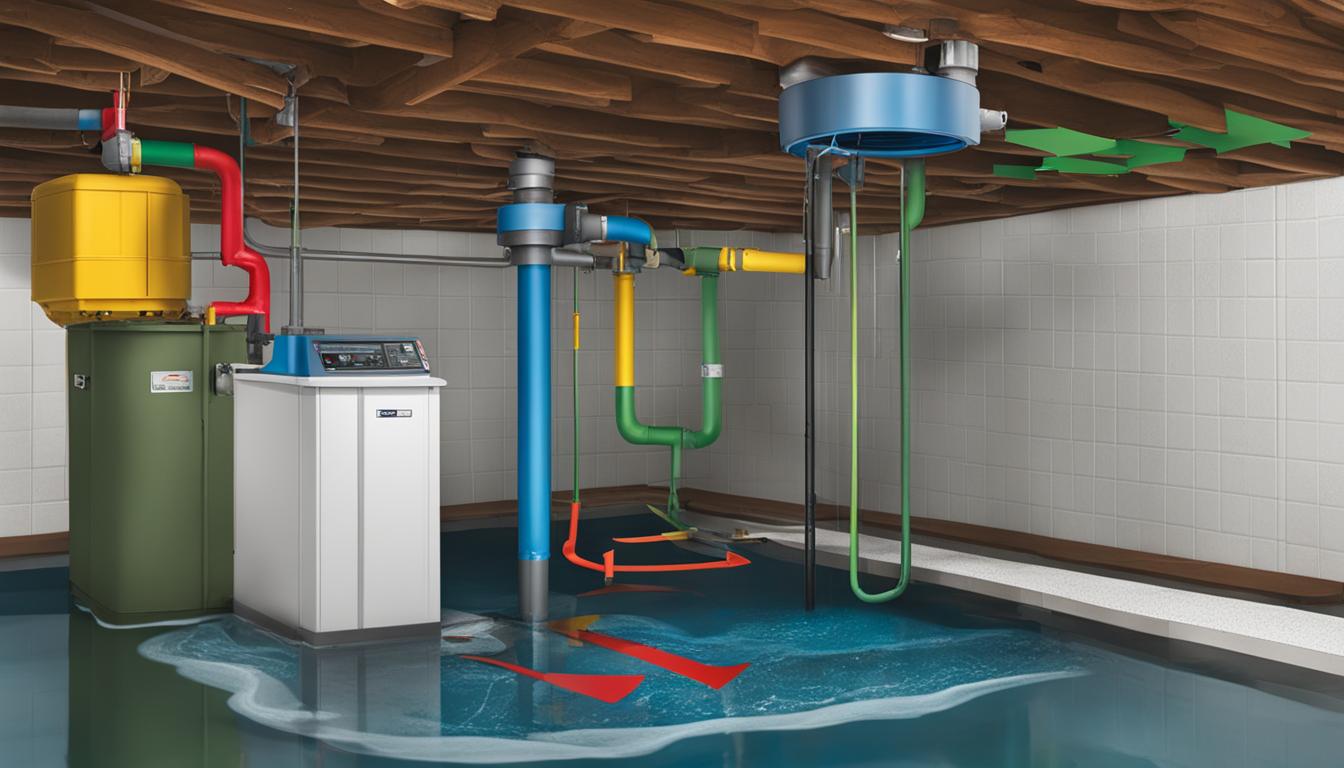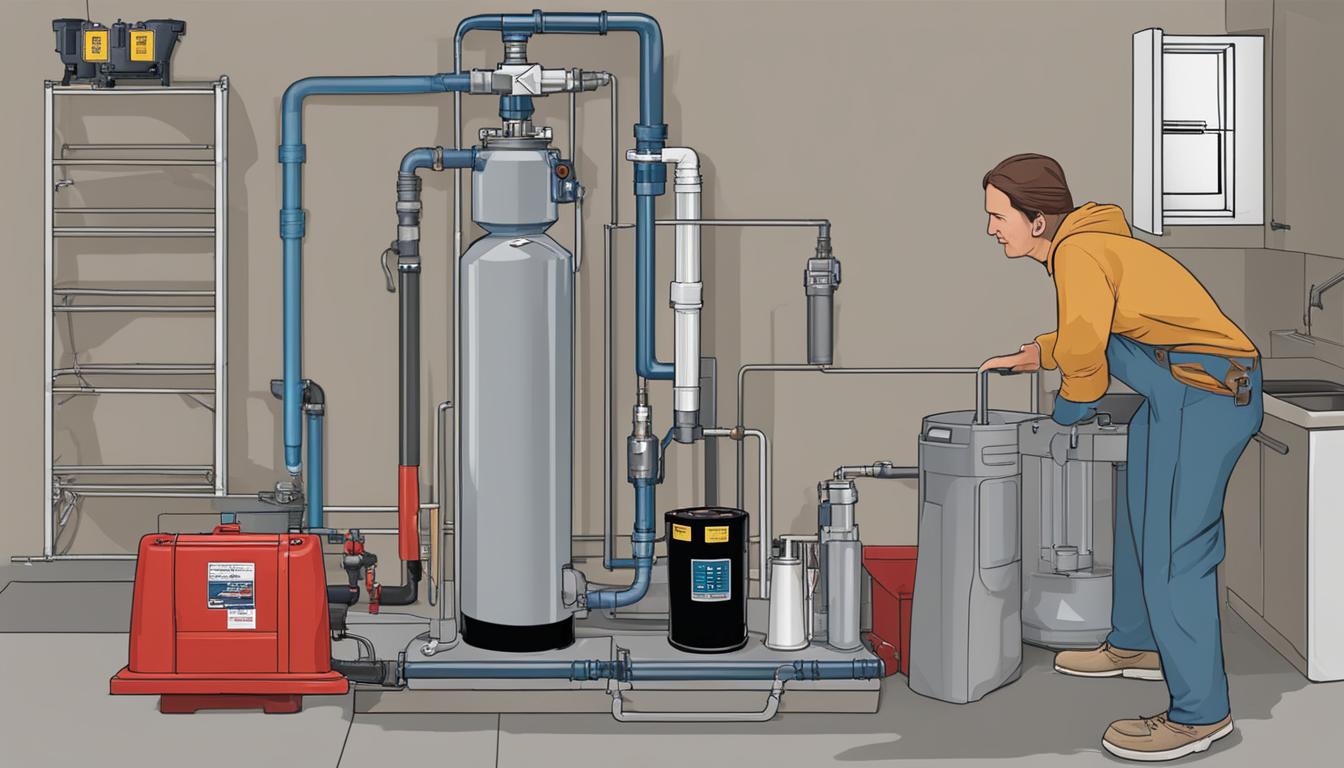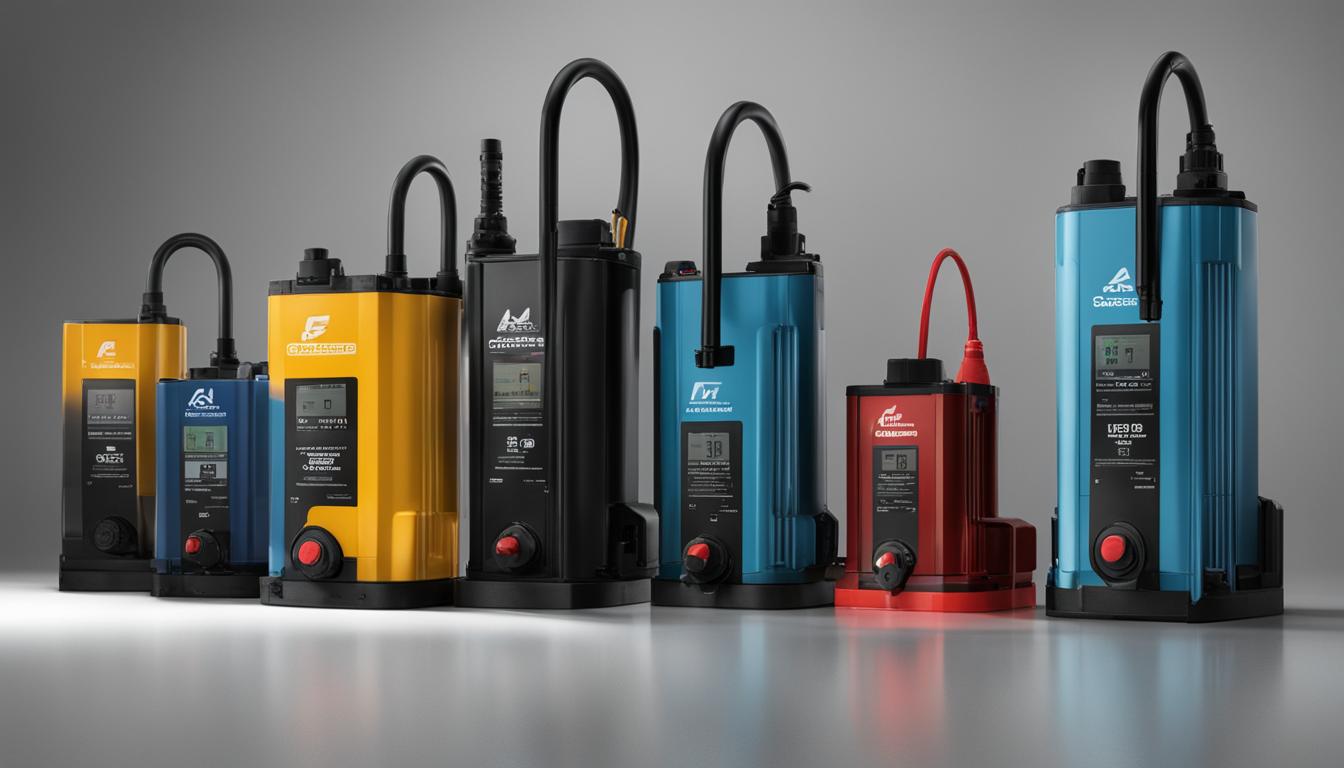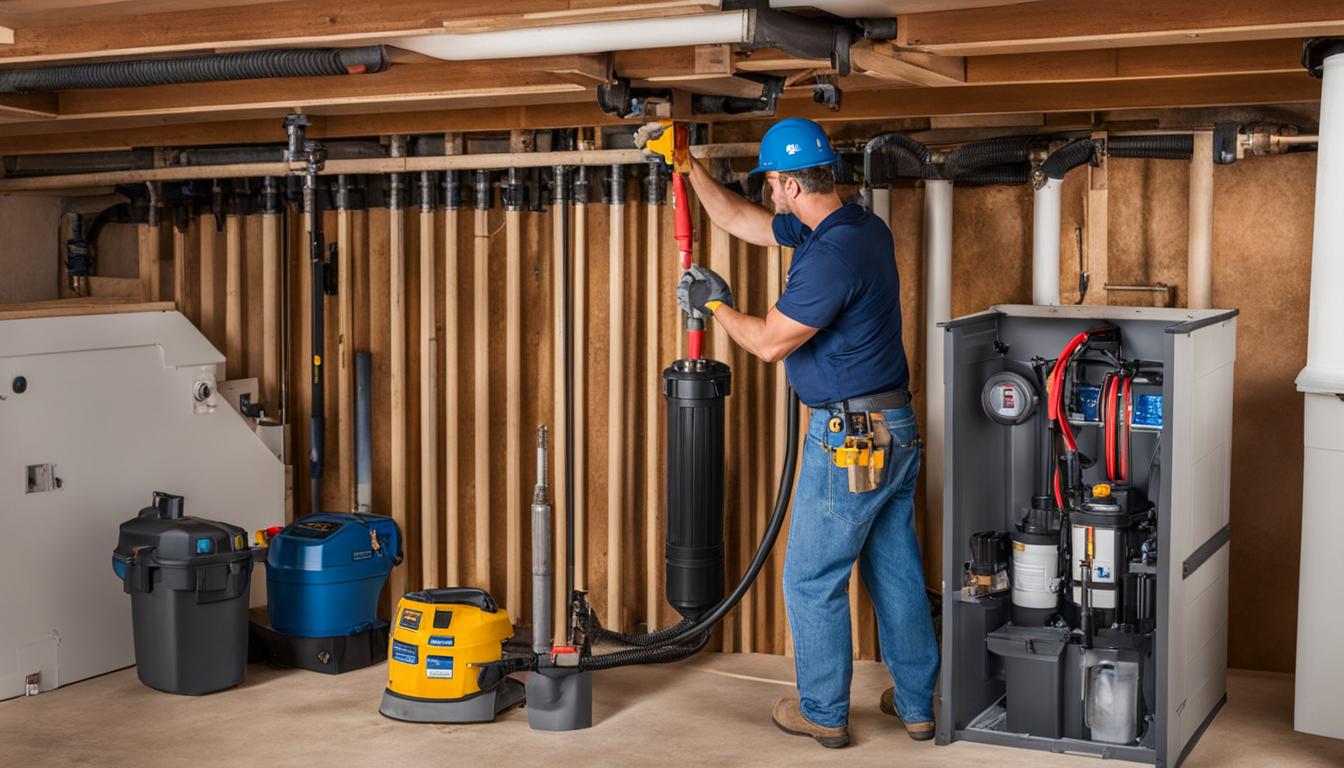Welcome to our guide on pedestal sump pumps and their suitability for homes in the United States. When it comes to protecting your basement from floods, having the right sump pump is crucial. In this article, we will explore the benefits and drawbacks of using pedestal sump pumps, ensuring that your basement remains flood-free throughout the year.
Key Takeaways:
- Pedestal sump pumps are a popular choice for homeowners looking to prevent floods in their basements.
- They are space-saving, easy to maintain, and offer efficient flood prevention capabilities.
- Proper installation and regular maintenance are important for ensuring optimal performance and longevity.
- Noise levels can be a concern, but there are ways to minimize disturbances.
- When choosing a sump pump, it’s important to consider your specific needs and choose the option that best suits them.
Understanding Sump Pump Solutions for Basements
When it comes to basement solutions for preventing floods, sump pumps are a popular choice. There are two main options available: submersible pumps and pedestal pumps.
Submersible pumps are installed underwater and are often preferred for their efficiency in removing large volumes of water. On the other hand, pedestal pumps are installed above ground and are a space-saving solution for smaller basements.
Comparing Submersible Pumps and Pedestal Pumps
Let’s take a closer look at the differences between submersible pumps and pedestal pumps.
| Aspect | Submersible Pumps | Pedestal Pumps |
|---|---|---|
| Installation | Installed underwater | Installed above ground |
| Space | Require more space | Space-saving |
| Noise | Run quieter | Can be noisier |
| Maintenance | Harder to maintain | Easier to maintain |
| Price | More expensive | Less expensive |
As shown in the table, submersible pumps require more space and are often more expensive, making them suitable for larger basements. Pedestal pumps offer a space-saving solution and are often easier to maintain, making them a more affordable option and ideal for smaller basements.
Ultimately, the choice between submersible pumps and pedestal pumps depends on individual needs and the specific dimensions and requirements of each basement.
Comparing Pedestal Sump Pumps and Submersible Pumps
When considering which sump pump to install in your basement, it’s essential to compare the different options available. In this section, we will compare pedestal sump pumps and submersible pumps, two popular choices for basement flood prevention.
Pump Comparison
One of the primary differences between pedestal and submersible sump pumps is their physical design. Pedestal pumps feature a motor that sits above the sump pit, while submersible pumps are entirely submerged in water. This design variation impacts several critical factors, such as pumping capacity, efficiency, and noise levels.
Flood Prevention
Both pedestal sump pumps and submersible pumps offer excellent flood prevention capabilities. However, pedestal pumps are better suited for basements with a lower water table. As they draw water from the pit’s surface, they may not be sufficient for homes in regions with frequent and heavy rainfall. Submersible pumps are more powerful and can handle a higher volume of water, making them a more suitable option for homes in flood-prone areas.
Pump Efficiency
When it comes to pump efficiency, submersible pumps are generally more efficient than pedestal pumps. Submersible pumps can move a more significant volume of water per hour and consume less energy, making them a cost-effective option in the long run. Pedestal pumps may be less efficient, but they make up for it with their low maintenance requirements and long lifespan.
| Pump Type | Pumping Capacity | Power Consumption | Noise Levels |
|---|---|---|---|
| Pedestal Sump Pump | 2400-3000 GPH | 1/4 – 1/3 HP | Higher Noise Levels |
| Submersible Sump Pump | 4000-5000 GPH | 1/2 – 1 HP | Lower Noise Levels |
Overall, both pedestal and submersible sump pumps offer benefits and drawbacks depending on your specific needs. It’s important to consider factors such as pumping capacity, power consumption, and noise levels when choosing the best option for your basement.
Benefits of Pedestal Sump Pumps
When considering a sump pump solution for your basement, pedestal sump pumps offer several benefits that make them a popular choice among homeowners. Let’s explore the advantages of using pedestal sump pumps:
Space Saving Design
One of the primary advantages of pedestal sump pumps is their space-saving design. These pumps have a vertical float switch that sits on top of a long, slender pedestal, which is installed outside the sump pit. This design allows for easy access to the pump when maintenance is required and frees up valuable space in your basement.
Reduced Noise Levels
Another benefit of pedestal sump pumps is their reduced noise levels. Since the motor is installed outside the sump pit, they are quieter than submersible pumps. This makes them a more suitable choice for homeowners who are sensitive to noise or have living spaces close to the sump pit.
Ease of Maintenance
Proper maintenance is crucial for the longevity and efficient performance of your sump pump. The good news is that maintaining a pedestal sump pump is relatively easy. The motor and impeller are located above the sump pit, which makes them accessible for cleaning and repair. Additionally, since the pedestal sump pump is installed outside the sump pit, there is no need to remove the entire pump from the pit for maintenance or repair.
In conclusion, pedestal sump pumps offer several benefits that make them an attractive choice for keeping your basement free from floods. The space-saving design, reduced noise levels, and ease of maintenance make them a popular choice among homeowners. In the next section, we will explore the drawbacks of using pedestal sump pumps to help you make an informed decision.
Drawbacks of Pedestal Sump Pumps
While pedestal sump pumps have their advantages, they also have some limitations that you should consider before making a purchase. One of the biggest drawbacks of pedestal sump pumps is their pump comparison to submersible pumps in terms of flood prevention. Due to their design, pedestal pumps are not as efficient in preventing floods as submersible pumps. This is primarily because pedestal pumps are installed above the sump pit, which means that they are not fully submerged in water.
Another consideration when it comes to pedestal sump pumps is their noise levels. As they are installed outside the sump pit, pedestal pumps tend to produce more noise than submersible pumps. This can be a concern if you have a living space above your basement, as the noise could be disruptive.
When it comes to maintenance, pedestal sump pumps are generally easy to maintain. However, due to their design, they can be more difficult to access and repair than submersible pumps. This could lead to higher maintenance costs and longer repair times.
| Drawback | Pedestal Sump Pumps | Submersible Pumps |
|---|---|---|
| Flood Prevention Efficiency | Less effective due to design | More effective due to being fully submerged |
| Noise Levels | Can be noisy due to external installation | Quieter due to being submerged |
| Maintenance | Easy to maintain but harder to access for repairs | Easy to access for repairs |
Despite these drawbacks, pedestal sump pumps can be an excellent choice for certain situations. For example, if your basement has limited space, a pedestal pump’s space-saving design might be ideal. Additionally, if noise is not a concern, and you are looking for an affordable option, a pedestal pump could be a great choice. Ultimately, the decision between pedestal and submersible pumps depends on your specific needs.
Ensuring Efficient Installation of Pedestal Sump Pumps
When it comes to installing a pedestal sump pump, it’s important to follow the proper steps to ensure optimal performance and efficiency. Here are some installation tips to keep in mind:
- Choose the right location: The location of your sump pump is crucial. Ensure that it is installed in the lowest point of your basement and away from any walls or corners. This will ensure that the water flows towards the pump and that it doesn’t get stuck in any corners.
- Prepare the sump pit: Clean out the sump pit thoroughly, removing any debris or sediment that might obstruct the pump’s intake. You should also check the pit for any cracks and repair them if necessary.
- Install the pump and check valve: Place the pedestal pump in the sump pit, ensuring that it is level. Next, attach the check valve to the pump’s outlet pipe, making sure it is facing upward. This will prevent any water from flowing back into the sump pit.
- Connect the pipe: Connect the pipe to the pump’s outlet and extend it to the outside of your home. Make sure that the pipe is at least 10 feet away from your home’s foundation and angled downward to ensure proper drainage.
- Electrical connections: Connect the pump’s electrical cord to a GFCI outlet to ensure safety. It’s also a good idea to install a battery backup system to ensure that the pump continues to function during power outages.
- Test the pump: Finally, test the pump to ensure that it’s working correctly. Fill the sump pit with water and observe the pump’s performance. If everything looks good, your pedestal sump pump is ready to keep your basement flood-free!
By following these installation tips, you can ensure that your pedestal sump pump is installed correctly and that it performs optimally, providing an efficient solution for your basement’s flood prevention needs.
Maintaining Your Pedestal Sump Pump for Longevity
Regular maintenance is crucial to ensure the optimal functioning and longevity of your pedestal sump pump. By following some basic maintenance tips, you can avoid unexpected breakdowns and costly repairs, ensuring your basement remains secure and flood-free.
The good news is, maintaining your pedestal sump pump is relatively easy, and you don’t need any special skills or tools to do it. Here are some essential tips to get you started:
Checking the Pump and its Components
It’s vital to inspect your pedestal sump pump and its components regularly to ensure they are in good working condition. Some of the things you should look out for include:
- The power cord – make sure it’s not frayed or damaged
- The float switch – ensure it moves freely and isn’t obstructed by debris
- The inlet screen – check for clogs or blockages that may impede water flow
- The impeller – ensure it’s free of debris and can move easily
By checking these components regularly, you can identify any issues before they escalate, preventing potential pump failure and basement flooding.
Cleaning the Pump
Cleaning your pedestal sump pump is a vital part of its maintenance routine. Over time, debris and sediment can accumulate in the pump, causing clogs and reducing its efficiency.
To clean your pedestal sump pump, follow these simple steps:
- Unplug the pump from the power source
- Remove the pump from the pit
- Disassemble the pump
- Clean all the components, including the impeller and inlet screen, with a soft brush or cloth
- Reassemble the pump and replace it in the pit
By cleaning your pedestal sump pump regularly, you can ensure it functions efficiently, preventing potential basement flood risks.
Testing the Pump
It’s important to test your pedestal sump pump regularly to ensure it can handle the volume of water that it’s likely to encounter during heavy rains or flooding.
To test your pump, follow these three simple steps:
- Pour water into the sump pit until the float activates the pump
- Observe the pump’s performance – it should start and stop automatically, pumping all the water out of the pit
- Ensure there are no leaks or unusual noises
By testing your pedestal sump pump regularly, you can ensure it’s ready to handle potential flooding, giving you peace of mind throughout the year.
Conclusion
Regular maintenance is essential to keep your pedestal sump pump in optimal working condition, minimizing the risk of basement flooding. By following these simple tips, you can maintain your pump’s efficiency, prolonging its lifespan, and avoiding costly repairs.
Noise Considerations for Pedestal Sump Pumps
A noisy sump pump can be a significant concern, especially if your basement is frequently used as a living space. Noise levels can vary depending on the type and model of the pump, and it’s crucial to consider noise levels when choosing a pedestal sump pump.
Pedestal sump pumps usually have a higher noise level than submersible pumps and can emit a high-pitched whine. However, it’s important to note that newer models have been designed to reduce noise levels significantly.
To minimize any potential disturbances, consider placing your pedestal sump pump in an enclosed basin or covering it with a sound-dampening cover. This will help reduce the noise level and make it more tolerable.
It’s also essential to keep your pump well-maintained to prevent any operational issues that could lead to increased noise levels. Regular maintenance, such as cleaning the pump and debris screen, can help keep your pump running smoothly and quietly.
Maximizing Flood Prevention with Pedestal Sump Pumps
At this point, you should be aware of the benefits and limitations of pedestal sump pumps. As we’ve discussed earlier, these pumps are an effective solution for preventing floods in your basement, but certain factors can influence their performance. In this section, we will provide you with some practical tips to ensure that your pedestal sump pump is working at maximum efficiency to keep your basement dry.
Proper Installation
First and foremost, proper installation is crucial for the smooth functioning of your pedestal sump pump. As we’ve mentioned before, ensure that the pump is placed on a solid surface, and the discharge pipe is securely placed outside the house. Also, make sure to follow the manufacturer’s instructions when installing the pump to avoid any damage. You may want to consider hiring a professional to install the pump for you if you’re unsure of how to proceed.
Regular Maintenance
Regular maintenance is essential to keep your pedestal sump pump running smoothly. Check the pump frequently for any signs of damage or wear and tear, such as cracks or clogs in the pipes. Make sure that the float switch is functioning correctly and that it’s not stuck or jammed. Also, clean the pump’s inlet screen regularly to prevent debris from building up and obstructing the pump’s operation.
Backup Power Source
In case of a power outage, your pedestal sump pump may stop working, leaving your basement vulnerable to flooding. To avoid such scenarios, consider installing a backup power source, such as a battery-powered pump or a generator, to ensure that the pump continues to function even during power outages.
Check Valve Installation
A check valve installed at the pump’s discharge pipe can prevent water from flowing back into the sump pit, causing the pump to cycle unnecessarily and reducing its lifespan. Ensure that the valve is installed correctly, and the flow direction is pointing towards the discharge line.
Regular Testing
It’s a good idea to test your pedestal sump pump regularly to ensure that it’s functioning correctly. You can do this by pouring water into the sump pit until the float switch activates the pump. If the pump fails to start, there may be an issue with the pump, and you should call a professional to diagnose and fix the problem.
Conclusion
Flood prevention in your basement is critical to protect your home and belongings. Pedestal sump pumps offer a reliable and effective solution for preventing floods, provided that you take the necessary precautions to ensure their optimal performance. Remember to install the pump correctly, perform regular maintenance, and test it regularly to keep your basement flood-free.
The Efficiency of Pedestal Sump Pumps
When it comes to investing in a sump pump for your basement, efficiency is a crucial factor to consider. You want a pump that can effectively remove water while consuming minimal energy. In this section, we will assess the efficiency of pedestal sump pumps and their effectiveness in minimizing energy consumption.
Pumping Capacity
The pumping capacity of a sump pump is the amount of water it can remove in a given time. Pedestal sump pumps tend to have a lower pumping capacity than submersible pumps, but they make up for it with their energy efficiency. These pumps can efficiently remove water from your basement while using less energy than other pump types.
Power Consumption
One of the key advantages of pedestal sump pumps is their low power consumption. They use less electricity than submersible pumps, making them a more cost-effective option in the long run. The energy efficiency of pedestal sump pumps means that they are less likely to burn out or malfunction, offering long-lasting performance and cost savings.
Maintenance Ease
Regular maintenance is essential to keep your sump pump in good working condition. Pedestal sump pumps are easy to maintain, which can contribute to their overall efficiency. These pumps have an above-ground design, which makes them more accessible and easier to inspect and repair.
Noise Considerations
Another factor to consider when assessing the efficiency of pedestal sump pumps is noise levels. These pumps tend to be noisier than submersible pumps, but advancements in technology have led to the development of quieter models. When choosing a pedestal sump pump, look for models that offer noise reduction features to minimize any potential noise disturbances.
Conclusion
Overall, pedestal sump pumps are an efficient solution for preventing basement floods while minimizing energy consumption. Their low power consumption and easy maintenance make them a cost-effective and practical choice for many homeowners. When choosing a sump pump, consider your specific needs and requirements to determine if a pedestal sump pump is the best option for your basement solutions.
Conclusion
In conclusion, pedestal sump pumps are an excellent choice for US homes looking to keep their basements flood-free. While they may not have the pumping capacity of submersible pumps, they offer several advantages, such as a space-saving design, reduced noise levels, and ease of maintenance.
However, it’s important to weigh the benefits against the drawbacks, such as limited pumping capacity and slightly higher noise levels. It’s crucial to choose the option that suits your specific needs and ensures efficient flood prevention.
Proper installation and regular maintenance are essential for maximizing the performance and efficiency of your pedestal sump pump. With the right setup and care, these pumps can effectively remove water from your basement while minimizing energy consumption.
Overall, pedestal sump pumps provide a valuable solution for US homeowners looking to keep their basements dry and secure. We hope this guide has provided you with the necessary insights to make an informed decision about the best sump pump solution for your home.
FAQ
How do pedestal sump pumps compare to submersible pumps?
Pedestal sump pumps and submersible pumps are two popular options for basement flood prevention. While submersible pumps are installed below the water level, pedestal pumps are mounted above the pit. Submersible pumps are generally more powerful and efficient, but pedestal pumps have the advantage of being easier to access for maintenance.
What are the benefits of using pedestal sump pumps?
Pedestal sump pumps offer several advantages. They have a space-saving design, as they are installed above the pit. They also tend to produce less noise compared to submersible pumps. Additionally, their exposed motor makes them easier to maintain and repair.
What are the drawbacks of using pedestal sump pumps?
While pedestal sump pumps have their benefits, they also have some limitations. One drawback is that they may not be as efficient as submersible pumps in removing large volumes of water. Additionally, the exposed motor can be more prone to damage from debris or flooding. Finally, some homeowners may find the visible motor and pipe less aesthetically pleasing.
What are some tips for installing pedestal sump pumps?
To ensure efficient installation, it’s important to follow a few key tips. First, make sure to position the pump at the correct height above the pit to allow for proper water drainage. Additionally, ensure that the discharge pipe is directed away from the foundation of the house. Finally, double-check all connections and test the pump before relying on it for flood prevention.
How do I maintain a pedestal sump pump?
Regular maintenance is essential for the longevity of your pedestal sump pump. Tasks such as cleaning the pit, testing the float switch, and inspecting the motor for any signs of damage should be performed periodically. It’s also a good idea to have a backup power source in case of a power outage. Consult the manufacturer’s instructions for specific maintenance guidelines.
Are pedestal sump pumps noisy?
Pedestal sump pumps generally produce less noise compared to submersible pumps. However, noise levels can still vary depending on the specific model and installation. To minimize potential disturbances, consider placing the pump on a vibration-absorbing pad and ensuring that all connections are securely tightened.
How can I maximize flood prevention with a pedestal sump pump?
To maximize flood prevention, it’s important to ensure that your pedestal sump pump is installed correctly and regularly maintained. Additionally, consider installing a backup power source to ensure the pump continues to function during power outages. Regularly check the pit for any blockages or debris that may hinder the pump’s performance.
How efficient are pedestal sump pumps?
Pedestal sump pumps can be efficient in removing water from your basement. However, they may not be as efficient as submersible pumps when it comes to pumping large volumes of water. It’s important to choose a pump with an appropriate pumping capacity for your specific needs and regularly monitor its performance.







